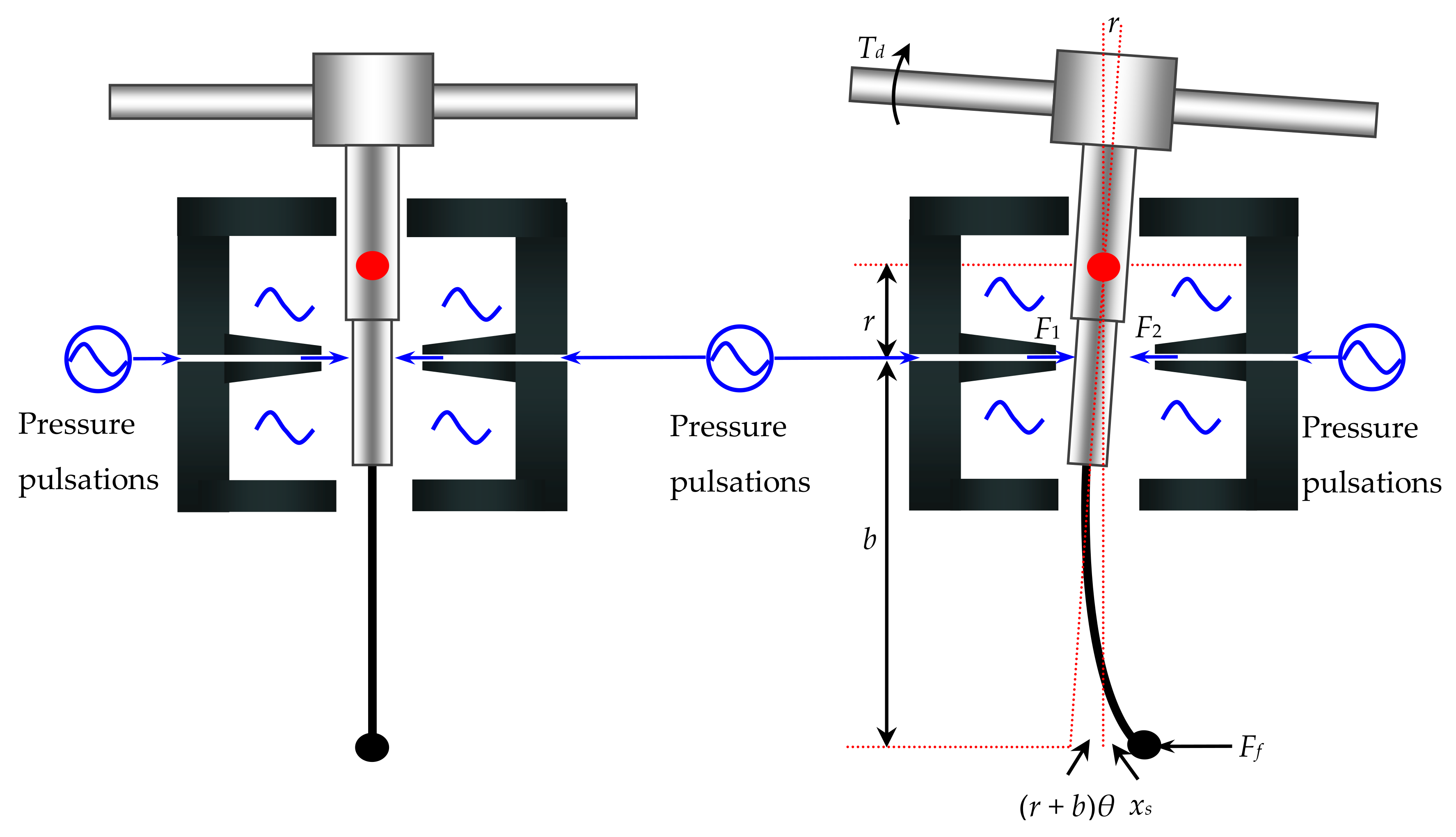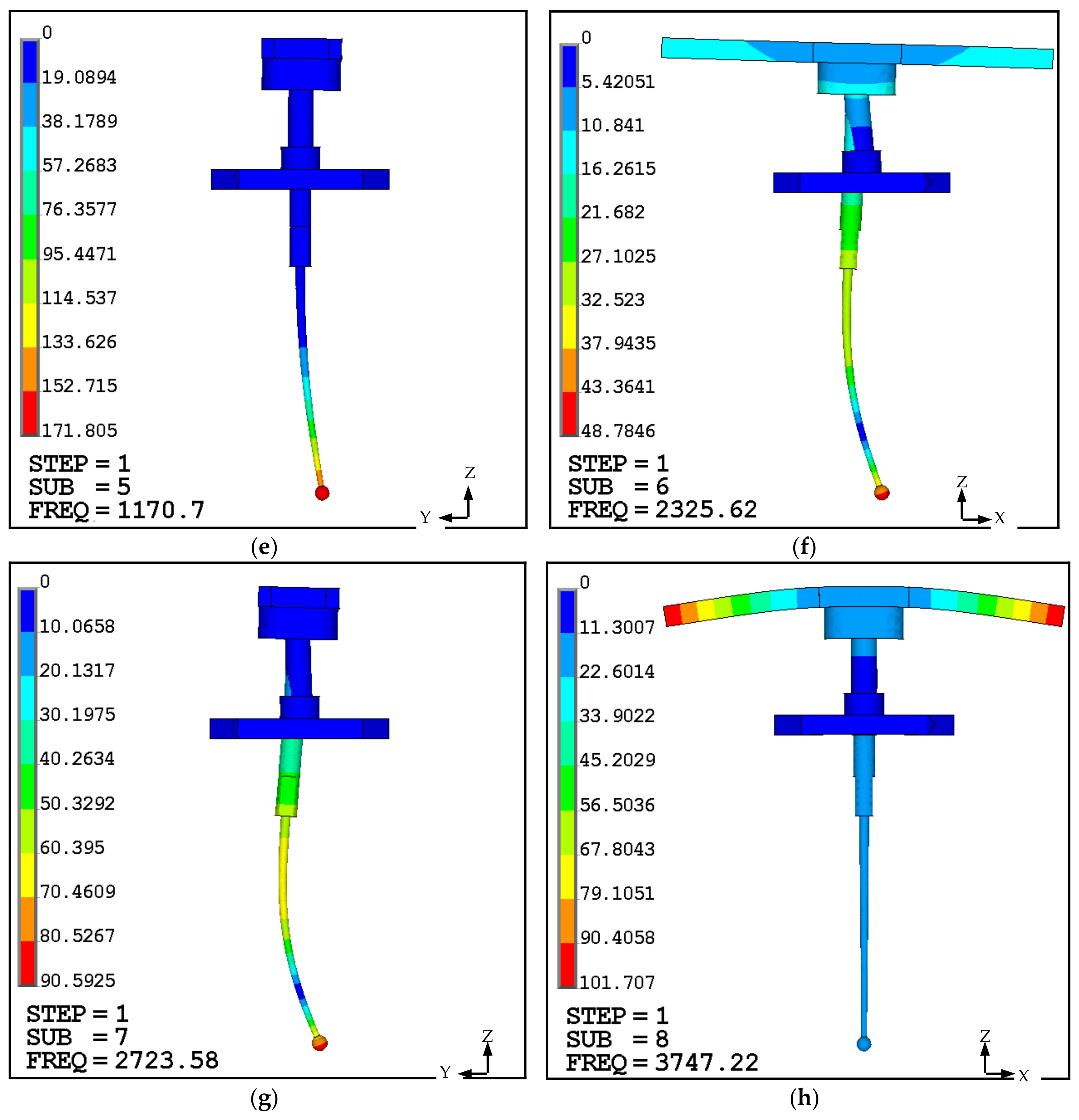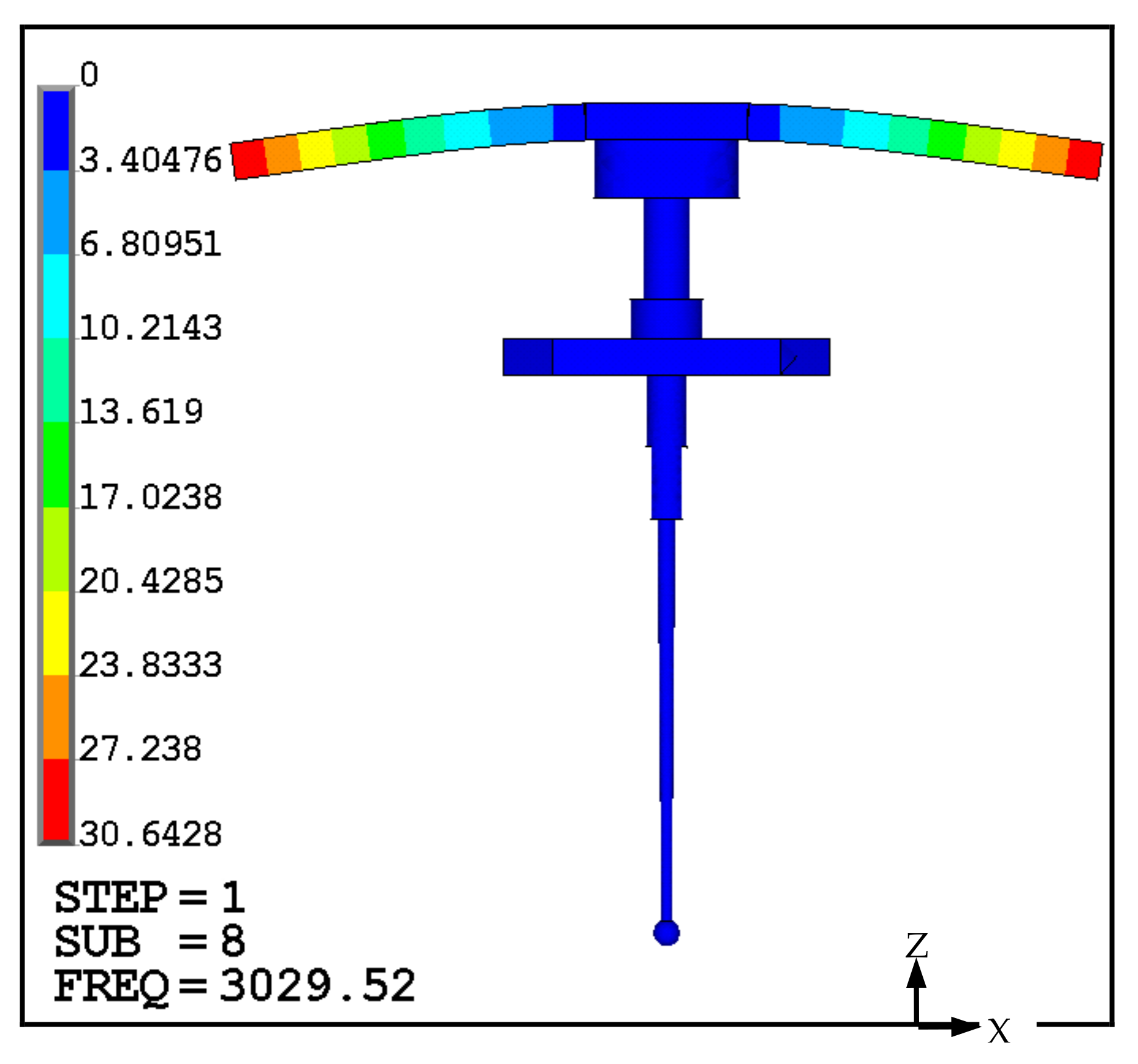Suppression of Squeal Noise Excited by the Pressure Pulsation from the Flapper-Nozzle Valve inside a Hydraulic Energy System
Abstract
:1. Introduction
2. Instability Analysis of the Flapper-Armature Assembly
2.1. Transmission of the Pressure Pulsations inside a Hydraulic Energy System
2.2. Forces Working on the Flapper-Armature Assembly
3. Modal Analysis of the Flapper-Armature Assembly
4. Measurement of the Pressure Pulsations, Vibration and Noise
5. Results and Discussion
5.1. Pressure Pulsations’ Characteristics
5.2. Armature Vibration Characteristics
5.3. Noise Characteristics
5.4. Results Comparison
5.5. Mechanism and Suppression of the Noise
6. Conclusions
Acknowledgments
Author Contributions
Conflicts of Interest
References
- Zhang, K.; Yao, J.; Jiang, T. Degradation assessment and life prediction of electro-hydraulic servo valve under erosion wear. Eng. Fail. Anal. 2014, 36, 284–300. [Google Scholar] [CrossRef]
- Li, S.; Song, Y. Dynamic response of a hydraulic servo-valve torque motor with magnetic fluids. Mechatronic 2007, 17, 442–447. [Google Scholar] [CrossRef]
- Li, S.; Bao, W. Influence of magnetic fluids on the dynamic characteristics of a hydraulic servo-valve torque motor. Mech. Syst. Signal Process. 2008, 22, 1008–1015. [Google Scholar] [CrossRef]
- Peng, J.H.; Fan, Y.B.; Li, S.J. Modeling of armature-flapper assembly in a hydraulic servo valve by finite element analysis and acoustic excitation measurements. In Proceedings of the International Conference on Fluid Power and Mechatronics IEEE, Harbin, China, 5–7 August 2015; pp. 301–306. [Google Scholar]
- Yi, D.; Lu, L.; Zou, J.; Fu, X. Squeal noise in hydraulic poppet valves. J. Zhejiang Univ. Sci. A 2016, 17, 317–324. [Google Scholar] [CrossRef]
- Porteiro, J.L.; Weber, S.T.; Rahman, M.M. An experimental study of flow induced noise in counterbalance valves. In Proceedings of the 4th International Symposium on Fluid-Structure Interactions Aeroelasticity Flow-Induced Vibration and Noise, Dallas, TX, USA, 16–21 November 1997; pp. 557–562. [Google Scholar]
- Watton, J. The effect of drain orifice damping on the performance characteristics of a servovalve flapper/nozzle stage. J. Dyn. Syst. Meas. Control 1987, 109, 19–23. [Google Scholar] [CrossRef]
- Smith, B.A.; Luloff, B.V. The effect of seat geometry on gate valve noise. J. Press. Vessel Technol. 2000, 122, 401–407. [Google Scholar] [CrossRef]
- Tamura, A.; Okuyama, K.; Takahashi, S.; Ohtsuka, M. Development of numerical analysis method of flow-acoustic resonance in stub pipes of safety relief valves. J. Nucl. Sci. Technol. 2012, 49, 793–803. [Google Scholar] [CrossRef]
- Janzen, V.P.; Smith, B.A.; Luloff, B.V. Acoustic noise reduction in large-diameter steam-line gate valves. In Proceedings of the ASME Pressure Vessels and Piping Conference, San Antonio, TX, USA, 22–26 July 2007; pp. 513–522. [Google Scholar]
- Yonezawa, K.; Ogawa, R.; Ogi, K. Flow-induced vibration of a steam control valve. J. Fluids Struct. 2012, 35, 76–88. [Google Scholar] [CrossRef]
- Misra, A.; Behdinan, K.; Cleghorn, W.L. Self-excited vibration of a control valve due to fluid-structure interaction. J. Fluids Struct. 2002, 16, 649–665. [Google Scholar] [CrossRef]
- Wakui, S.; Watanabe, T.; Takahashi, M. An identification of vibration reduction of nozzle-flapper type servo valve using in an air-spring type anti-vibration apparatus and reduced vibration effect on isolated table. Trans. Jpn. Soc. Mech. Eng. C 2009, 75, 1941–1949. [Google Scholar] [CrossRef]
- Bergada, J.M.; Codina, E. Discharge coefficients for a four nozzle two flapper servovalve. In Proceedings of the National Conference on Fluid Power, Chicago, IL, USA, 23–24 March 1994; pp. 213–218. [Google Scholar]
- Kawashima, K.; Youn, C.; Kagawa, T. Development of a nozzle-flapper-type servo valve using a slit structure. J. Fluids Eng. 2007, 129, 573–578. [Google Scholar] [CrossRef]
- Peng, J.; Li, S.; Fan, Y. Modeling and parameter identification of the vibration characteristics of armature assembly in a torque motor of hydraulic servo valves under electromagnetic excitations. Adv. Mech. Eng. 2014, 6, 247384. [Google Scholar] [CrossRef]
- Li, S.J.; Aung, N.Z.; Zhang, S.Z. Experimental and numerical investigation of cavitation phenomenon in flapper-nozzle pilot stage of an electrohydraulic servo-valve. Comput. Fluids 2013, 88, 590–598. [Google Scholar] [CrossRef]
- Aung, N.Z.; Li, S.J. A numerical study of cavitation phenomenon in a flapper-nozzle pilot stage of an electrohydraulic servo-valve with an innovative flapper shape. Energy Convers. Manag. 2014, 77, 31–39. [Google Scholar] [CrossRef]
- Zhang, S.Z.; Li, S.J. Cavity shedding dynamics in a flapper–nozzle pilot stage of an electro-hydraulic servo-valve: Experiments and numerical study. Energy Convers. Manag. 2015, 100, 370–379. [Google Scholar] [CrossRef]
- Jaroslav, I.; Monika, I. Hydrostatic Pumps and Motors: Principles, Design, Performance, Modelling, Analysis, Control and Testing, 1st ed.; Indian National Science Academy: New Delhi, India, 2000; pp. 185–203. [Google Scholar]
- Merritt, H.E. Hydraulic Control System, 1st ed.; John Wiley & Sons: New York, NY, USA, 1967; pp. 54–66. [Google Scholar]
- Harrison, K.A.; Edge, K.A. Reduction of axial piston pump pressure ripple. Proc. Inst. Mech. Eng. Part I J. Syst. Control Eng. 2000, 214, 53–64. [Google Scholar] [CrossRef]
- Kim, J.K.; Kim, H.E.; Jung, J.Y.; Oh, S.H.; Jung, S.H. Relation between pressure variations and noise in axial type oil piston pumps. KSME Int. J. 2004, 18, 1019–1025. [Google Scholar] [CrossRef]
- Xu, B.; Ye, S.G.; Zhang, J.H. Flow ripple reduction of an axial piston pump by a combination of cross-angle and pressure relief grooves. Anal. Optim. J. Mech. Sci. Technol. 2016, 30, 2531–2545. [Google Scholar] [CrossRef]
- Gao, F.; Ouyang, X.; Yang, H.Y. A novel pulsation attenuator for aircraft piston pump. Mechatronic 2013, 23, 566–572. [Google Scholar] [CrossRef]
















| Group | Material | Young’s Modules (Pa) | Poisson’s Ratio | Density (kg·m−3) |
|---|---|---|---|---|
| Armature | 1J50 | 1.57 × 1011 | 0.3 | 8200 |
| Spring tube | QBe1.9 | 1.25 × 1011 | 0.35 | 8230 |
| Flapper and feedback rod | 3J1 | 1.9 × 1011 | 0.3 | 8000 |
| Mode | First | Second | Third | Fourth | Fifth | Sixth | Seventh | Eighth | |
|---|---|---|---|---|---|---|---|---|---|
| Frequency (Hz) | Type A | 489 | 554 | 690 | 1090 | 1171 | 2326 | 2724 | 3747 |
| Type B | 406 | 427 | 663 | 1072 | 1145 | 2132 | 2708 | 3030 | |
| Parameter | Density (kg/m3) | Viscosity (N·s/m2) | Surface Tension (N/m) |
|---|---|---|---|
| Liquid | 850 | 0.0085 | 0.0273 |
| Devices | Specifications | |
|---|---|---|
| Axial piston pump | Rated supply pressure | 18 MPa |
| Rated flow rate | 20 L/min | |
| Pistons number | 9 | |
| Servo-valve | Rated current | 10 mA |
| Rated supply pressure | 21 MPa | |
| Rated flow rate | 20 L/min | |
| Laser displacement sensor | Model | LK-G5000 KEYENCE Co., Ltd. |
| Measurement range | ±3 mm | |
| Resolution | 0.01 μm | |
| Piezoelectric microphone | Model | 130E22 PCBPIEZOTRONICS Co., Ltd. |
| Sensitivity | 45 mV/Pa | |
| Phase match (5 kHz–10 kHz) | ±10° | |
| Piezoelectric pressure sensor | Model | 113B22 PCBPIEZOTRONICS Co., Ltd. |
| Maximum pressure | 34 MPa | |
| Nonlinearity | <1% | |
| Pressure gauges | Maximum pressure | 16 MPa |
| Uncertainty | <1.5% | |
| Data acquisition board | Model | NI cDAQ-9172 |
| Group | Motor Speed (Rev/min) | Frequency | ||||
|---|---|---|---|---|---|---|
| Equation (1) (Hz) | Pressure-A (Hz) | Pressure-B (Hz) | Vibration (Hz) | Noise (Hz) | ||
| N1 | 10,400 | 3120 | 3090 | 3104 | 3064 | 3092 |
| N2 | 11,400 | 3420 | 3382 | 3402 | 3378 | 3452 |
| N3 | 12,400 | 3720 | 3734 | 3726 | 3708 | 3724 |
| N4 | 13,400 | 4020 | 4042 | 4024 | 3992 | 4058 |
| N5 | 14,400 | 4320 | 4304 | 4326 | 4398 | 4314 |
| Group | Primary Frequencies and Amplitudes | |||||||
|---|---|---|---|---|---|---|---|---|
| Pressure-A | Pressure-B | Vibration | Noise | |||||
| Frequency (Hz) | Amplitude (Pa) | Frequency (Hz) | Amplitude (Pa) | Frequency (Hz) | Amplitude (μm) | Frequency (Hz) | Amplitude (Pa) | |
| N1 | 3090 | 120,487 | 3104 | 85,835 | 3064 | 5.07 | 3092 | 0.26 |
| N2 | 3382 | 130,357 | 3402 | 92,764 | 3378 | 6.89 | 3452 | 0.35 |
| N3 | 3734 | 592,878 | 3726 | 889,317 | 3708 | 48.64 | 3724 | 2.96 |
| N4 | 4042 | 191,766 | 4024 | 143,612 | 3992 | 8.95 | 4058 | 0.58 |
| N5 | 4304 | 340,646 | 4326 | 252,543 | 4398 | 14.91 | 4314 | 0.92 |
| Group | Primary Frequencies and Amplitudes | |||||||
|---|---|---|---|---|---|---|---|---|
| Pressure-A | Pressure-B | Vibration | Noise | |||||
| Frequency (Hz) | Amplitude (Pa) | Frequency (Hz) | Amplitude (Pa) | Frequency (Hz) | Amplitude (μm) | Frequency (Hz) | Amplitude (Pa) | |
| N1 | 3198 | 118,364 | 3206 | 82,493 | 3190 | 4.35 | 3194 | 0.21 |
| N2 | 3386 | 134,612 | 3394 | 90,502 | 3390 | 6.14 | 3414 | 0.32 |
| N3 | 3742 | 160,457 | 3718 | 134,317 | 3736 | 7.82 | 3730 | 0.45 |
| N4 | 4040 | 186,391 | 4084 | 158,413 | 4052 | 9.27 | 4068 | 0.62 |
| N5 | 4328 | 325,489 | 4332 | 227,358 | 4364 | 12.08 | 4384 | 0.87 |
© 2018 by the authors. Licensee MDPI, Basel, Switzerland. This article is an open access article distributed under the terms and conditions of the Creative Commons Attribution (CC BY) license (http://creativecommons.org/licenses/by/4.0/).
Share and Cite
Chen, M.; Xiang, D.; Li, S.; Zou, C. Suppression of Squeal Noise Excited by the Pressure Pulsation from the Flapper-Nozzle Valve inside a Hydraulic Energy System. Energies 2018, 11, 955. https://doi.org/10.3390/en11040955
Chen M, Xiang D, Li S, Zou C. Suppression of Squeal Noise Excited by the Pressure Pulsation from the Flapper-Nozzle Valve inside a Hydraulic Energy System. Energies. 2018; 11(4):955. https://doi.org/10.3390/en11040955
Chicago/Turabian StyleChen, Meng, Dong Xiang, Songjing Li, and Changfang Zou. 2018. "Suppression of Squeal Noise Excited by the Pressure Pulsation from the Flapper-Nozzle Valve inside a Hydraulic Energy System" Energies 11, no. 4: 955. https://doi.org/10.3390/en11040955





